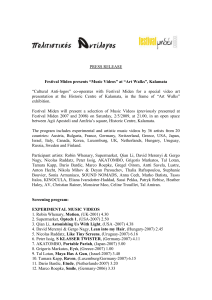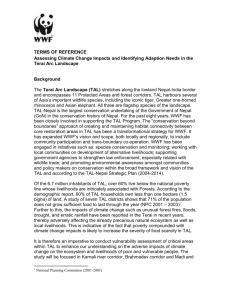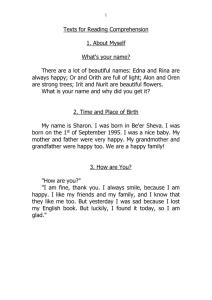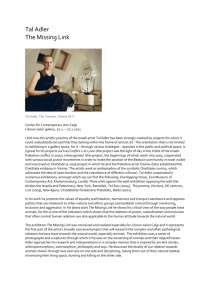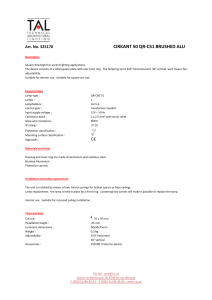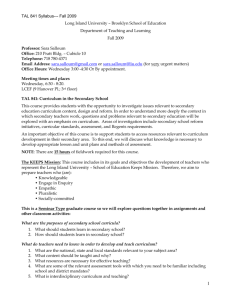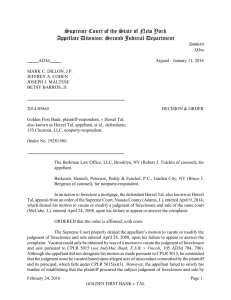Foundational Typed Assembly Language with Certified Garbage Collection
advertisement
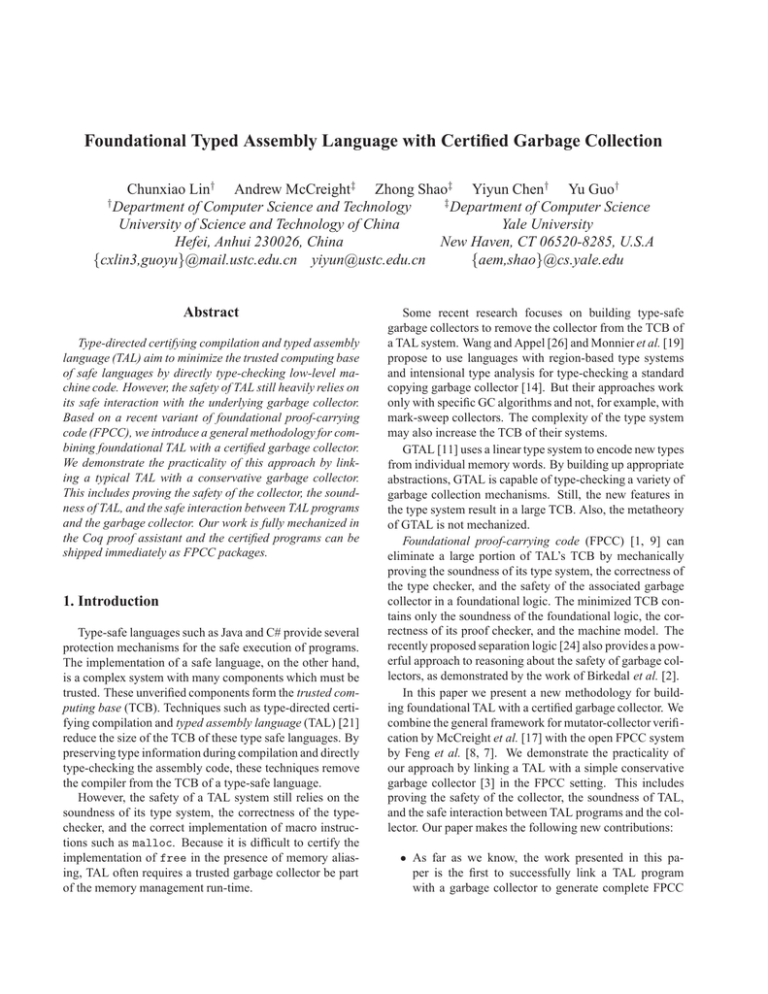
Foundational Typed Assembly Language with Certified Garbage Collection
Chunxiao Lin† Andrew McCreight‡ Zhong Shao‡ Yiyun Chen† Yu Guo†
†
‡
Department of Computer Science and Technology
Department of Computer Science
University of Science and Technology of China
Yale University
Hefei, Anhui 230026, China
New Haven, CT 06520-8285, U.S.A
{cxlin3,guoyu}@mail.ustc.edu.cn yiyun@ustc.edu.cn
{aem,shao}@cs.yale.edu
Abstract
Type-directed certifying compilation and typed assembly
language (TAL) aim to minimize the trusted computing base
of safe languages by directly type-checking low-level machine code. However, the safety of TAL still heavily relies on
its safe interaction with the underlying garbage collector.
Based on a recent variant of foundational proof-carrying
code (FPCC), we introduce a general methodology for combining foundational TAL with a certified garbage collector.
We demonstrate the practicality of this approach by linking a typical TAL with a conservative garbage collector.
This includes proving the safety of the collector, the soundness of TAL, and the safe interaction between TAL programs
and the garbage collector. Our work is fully mechanized in
the Coq proof assistant and the certified programs can be
shipped immediately as FPCC packages.
1. Introduction
Type-safe languages such as Java and C# provide several
protection mechanisms for the safe execution of programs.
The implementation of a safe language, on the other hand,
is a complex system with many components which must be
trusted. These unverified components form the trusted computing base (TCB). Techniques such as type-directed certifying compilation and typed assembly language (TAL) [21]
reduce the size of the TCB of these type safe languages. By
preserving type information during compilation and directly
type-checking the assembly code, these techniques remove
the compiler from the TCB of a type-safe language.
However, the safety of a TAL system still relies on the
soundness of its type system, the correctness of the typechecker, and the correct implementation of macro instructions such as malloc. Because it is difficult to certify the
implementation of free in the presence of memory aliasing, TAL often requires a trusted garbage collector be part
of the memory management run-time.
Some recent research focuses on building type-safe
garbage collectors to remove the collector from the TCB of
a TAL system. Wang and Appel [26] and Monnier et al. [19]
propose to use languages with region-based type systems
and intensional type analysis for type-checking a standard
copying garbage collector [14]. But their approaches work
only with specific GC algorithms and not, for example, with
mark-sweep collectors. The complexity of the type system
may also increase the TCB of their systems.
GTAL [11] uses a linear type system to encode new types
from individual memory words. By building up appropriate
abstractions, GTAL is capable of type-checking a variety of
garbage collection mechanisms. Still, the new features in
the type system result in a large TCB. Also, the metatheory
of GTAL is not mechanized.
Foundational proof-carrying code (FPCC) [1, 9] can
eliminate a large portion of TAL’s TCB by mechanically
proving the soundness of its type system, the correctness of
the type checker, and the safety of the associated garbage
collector in a foundational logic. The minimized TCB contains only the soundness of the foundational logic, the correctness of its proof checker, and the machine model. The
recently proposed separation logic [24] also provides a powerful approach to reasoning about the safety of garbage collectors, as demonstrated by the work of Birkedal et al. [2].
In this paper we present a new methodology for building foundational TAL with a certified garbage collector. We
combine the general framework for mutator-collector verification by McCreight et al. [17] with the open FPCC system
by Feng et al. [8, 7]. We demonstrate the practicality of
our approach by linking a TAL with a simple conservative
garbage collector [3] in the FPCC setting. This includes
proving the safety of the collector, the soundness of TAL,
and the safe interaction between TAL programs and the collector. Our paper makes the following new contributions:
• As far as we know, the work presented in this paper is the first to successfully link a TAL program
with a garbage collector to generate complete FPCC
packages. The type system of our TAL contains nontrivial features such as mutable references, recursive
types, and union types, and is capable of typing mutable recursive data structures. The collector we verified
is a conservative variant of a standard stop-the-world
mark-sweep collector [14].
• Although our current paper only shows how to safely
link TAL with a certified conservative collector, our
methodology is general, capable of verifying more
complex situations, such as the TAL type system keeping complex information for an accurate collector or
even an incremental collector with read/write barriers.
• We specify the collector using the stack-based certified assembly programming (SCAP) framework [8]
extended with separation-logic primitives [24]. Our
specification asserts the machine-level behavior of the
collector and is general enough for various mutator
safety requirements besides type safety. The safety
proof of our collector, which is done using SCAP, is
a nontrivial work by itself.
• The work presented in this paper is fully mechanized
within the Coq proof assistant [5]. Thus, the linked
code of the mutator and collector can immediately be
shipped as an FPCC package with a minimal TCB.
We have also developed various mechanisms in Coq
to simplify proof construction.
In Section 2, we introduce the preliminary knowledge
needed to understand the rest of the paper. In Section 3,
we present our general methodology for building TAL with
certified garbage collection. In Sections 4–6 we apply this
methodology to verify the safe interaction of a TAL with
a conservative collector. We discuss the implementation in
Section 7. Finally, we discuss related work and conclude.
Note that all lemmas and theorems in this paper are mechanically proved in Coq. Their detailed proofs are available on our project web site [16].
2. Basic setting
Before presenting our general methodology we give a
general introduction to the FPCC system that our work uses.
This includes a MIPS32-style [18] abstract machine model
and the lightweight open framework for certified assembly
programming [7] (LOCAP), a program logic for reasoning
about the interaction of two different verification systems.
We also present the embedding of SCAP [8] in LOCAP. As
demonstrated by Feng et al. [8, 7], SCAP is suitable for
certifying system level libraries, and we use it to construct
the safety proof for our garbage collector.
Both the machine model and the program logic are formalized within a mechanized meta-logic, the Calculus of
(P rog)
(CdHeap)
(State)
(Heap)
(RF ile)
(Reg)
(W d, Lab)
(Address)
(ISeq)
P
C
S
H
R
r
w, f
l
I
(Comm)
c
::=
::=
::=
::=
::=
::=
::=
::=
::=
|
|
::=
|
|
|
(C, S, I)
{f ; I}∗
(H, R)
{l ; w}∗
{r ; w}∗
{rk}k∈{0...31}
0 | 1 | 2 | ...
0 | 4 | 8 | ...
c; I | beq rs , rt , f; I
bne rs , rt , f; I
j f | jal f, fret | jr rs
addu rd , rs , rt | addiu rd , rs , w
subu rd , rs , rt | srl rd , rs , 1
sltu rd , rs , rt | andi rd , rs , 7
lw rd , w(rs ) | sw rs , w(rd )
Figure 1. Abstract machine syntax
Inductive Construction (CiC) [23], as implemented in the
Coq proof assistant [5]. CiC is a higher-order predicate
logic extended with inductive definitions. The CiC terms
in this paper are written using standard logical notation. We
let P rop be the universe of all logical propositions and Set
be the universe of all computational terms.
2.1. Abstract machine
Figure 1 gives the syntax of our abstract machine. A program P is a triple of a code heap C, a machine state S and
an instruction sequence I. A code heap C is a partial map
from code labels f to instruction sequences I. A machine
state S contains a data heap H and a register file R. A data
heap H is a partial map from 4-byte aligned addresses l to
word values w, while a register file R is a map from registers
r to word values, with r0 always mapped to 0. A command
c is a non-control-flow instruction such as a register add or
a heap load. An instruction sequence I, or code block, is a
series of commands and branches followed by an unconditional jump instruction. For simplicity, we separate the code
heap C from the mutable data heap H. Also, we use an instruction sequence instead of the standard pc register. This
results in the additional return address fret in the jump and
link instruction jal f, fret . By expanding this instruction
to the MIPS instruction pair jal f and j fret , all our certified code [16] can directly run on the SPIM simulator [15].
Following [18], we give the small step operational semantics of the abstract machine in Figure 2. We write X(z)
for the value bound to z in the map X, and X{z ; v} for
the map obtained by updating the binding of z to v in X.
Note that for a lw/sw command, if the source address is not
in the domain of the heap, the next state is undefined. The
next step of a program is undefined if it jumps to an invalid
label or the next state of its first command is undefined.
if I =
jf
jal f, fret
jr rs
beq rs , rt , f; I′
bne rs , rt , f; I′
c; I′
if c =
addu rd , rs , rt
addiu rd , rs , w
subu rd , rs , rt
srl rd , rs , 1
sltu rd , rs , rt
andi rd , rs , 7
lw rd , w(rs )
sw rs , w(rd )
then (C, (H, R), I) 7−→
if f ∈ dom(C), (C, (H, R), C(f))
if f ∈ dom(C),
(C, (H, R{r31 ; fret }), C(f))
if R(rs ) ∈ dom(C),
(C, (H, R), C(R(rs )))
if R(rs ) 6= R(rt ), (C, (H, R), I′ ),
else if f ∈ dom(C), (C, (H, R), C(f))
if R(rs ) = R(rt ), (C, (H, R), I′ ),
else if f ∈ dom(C), (C, (H, R), C(f))
if Nextc ((H, R)) = S′ , (C, S′ , I′ )
then Nextc (H, R)=
(H, R{rd ; R(rs ) + R(rt )})
(H, R{rd ; R(rs ) + w})
(H, R{rd ; R(rs ) − R(rt )})
(H, R{rd ; R(rs )/2})
(H, R{rd ; k})
if R(rs ) < R(rt ), k = 1, else k = 0
(H, R{rd ; R(rs ) mod 8})
if (R(rs ) + w) ∈ dom(H),
(H, R{rd ; H(R(rs ) + w)})
if (R(rd ) + w) ∈ dom(H),
(H{R(rd ) + w ; R(rs )}, R)
Figure 2. Abstract machine semantics
(CdSpec)
(ChSpec)
(Assert)
(Interp)
a ⇒ a′
Ψ ⊆ Ψ′
haiΨ′
θ
Ψ
a
[[ ]]
def
=
def
=
def
=
::=
::=
∈
∈
··· | ···
{(l, θ)}∗
ChSpec → State → P rop
CdSpec → Assert
∀Ψ, S. a Ψ S → a′ Ψ S
∀(f, θ). (f, θ) ∈ Ψ → (f, θ) ∈ Ψ′
λΨ, S. Ψ′ ⊆ Ψ ∧ a Ψ S
Figure 3. LOCAP specification constructs
Ψ ⊢ P (Well-formed Program)
Ψ⊢C:Ψ
(a Ψ S)
⊢ {a} I
Ψ ⊢ (C, S, I)
(PROG)
Ψ ⊢ C : Ψ′ (Well-formed Code Heap)
⊢ {h[[θ]]iΨ } C(f)
∀(f, θ) ∈ Ψ′
Ψ ⊢ C : Ψ′
(CDHP)
⊢ {a} I (Well-formed Instruction Sequence)
a ⇒ λΨ, S. ∃θ. (f, θ) ∈ Ψ ∧ [[θ]] Ψ S
(J)
⊢ {a} j f
a ⇒ λΨ, (H, R). ∃θ.
(R(rs ), θ) ∈ Ψ ∧ [[θ]] Ψ (H, R)
(JR)
⊢ {a} jr rs
2.2. Program logic
The readers may view LOCAP as a simplified OCAP [7],
or an extended CAP0 [8]. We use it to embed two verification systems, namely TAL and SCAP. As listed in Figure 3,
the specification of a code block is given by θ. This may be
a state predicate in Hoare logic [12], a register file type in
TAL, or anything else. LOCAP is a simplification of OCAP
because there are only two kinds of code block specifications, so the language dictionary of OCAP is not needed. A
code heap specification Ψ is a set of (f, θ) pairs. Therefore,
a code block may have more than one kind of specification
in Ψ. We utilize this property to specify the GC interface for
TAL. The interpretation function [[ ]] translates θ into a predicate a over the environment Ψ and the machine state, to
allow a to specify the code pointers (labels of code blocks)
in Ψ. Both θ and [[ ]] will be instantiated for TAL and SCAP
in our following discussion. Finally, ⇒ is the implication
relation on assertions and a lifted assertion haiΨ combines
a with all the information in Ψ.
We show the LOCAP inference rules in Figure 4. A
well-formed program is a well-formed code heap with an
appropriate initial state. A code heap C is well-formed with
respect to Ψ if each pair in Ψ corresponds to a well-formed
code block in C. Interested readers may find the detailed
explanation of the rules in [7], but this is not required for
understanding the rest of the paper.
a ⇒ λΨ, (H, R). ∃θ.
(f, θ) ∈ Ψ ∧ [[θ]] Ψ (H, R{r31 ; fret })
(JAL )
⊢ {a} jal f, fret
⊢ {a′ } I
a ⇒ λΨ, S. a′ Ψ Nextc (S)
⊢ {a} c; I
(SEQ)
Figure 4. LOCAP inference rules (excerpt)
The weakening lemma states that if a code block is wellformed with some a′ , it is also well-formed with a stronger
assertion a, and the proof of a well-formed code block can
be lifted from a local Ψ to a global Ψ′ .
Lemma 1 (Weakening).
1. If a ⇒ a′ and ⊢ {a′ } I, then: ⊢ {a} I;
2. If Ψ ⊆ Ψ′ and ⊢ {haiΨ } I, then: ⊢ {haiΨ′ } I.
The soundness-correctness theorem of the CAP system
ensures that a well-formed program will run forever without
reaching any undefined steps in Figure 2, and the partial
correctness of the program against its specification holds.
Theorem 1 (Soundness-Correctness).
If Ψ ⊢ (C, S, I), for all natural number n there exists
a (C, S′ , I′ ), such that (C, S, I) 7−→n (C, S′ , I′ ); and if
(C, S′ , I′ ) 7−→ (C, S′′ , C(f)), then there exists a θ, such
that (f, θ) ∈ Ψ and [[θ]] Ψ S′′ .
(SP red)
(Guar)
(CdSpec)
p, q
g
θ
∈
∈
::=
State → P rop
State → State → P rop
(p, g)
wfst(0, q, Ψ) = ∀(H, R). q (H, R) →
∃Γ. (R(r31), Γ) ∈ Ψ ∧ [[Γ]]TAL Ψ (H, R)
def
wfst(n + 1, q, Ψ) = ∀(H, R). q (H, R) →
∃p, g. (R(r31), (p, g)) ∈ Ψ ∧ p (H, R)∧
wfst(n, g (H, R), Ψ)
def
[[(p, g)]]SCAP = λΨ, S. p S ∧ ∃n. wfst(n, g S, Ψ)
′′
(f, (p , g )) ∈ Ψ
(fret , (p , g )) ∈ Ψ
∀(H, R). p (H, R) → p′ (H, R{r31 ; fret })∧
∀S′ . g′ (H, R{r31 ; fret }) S′ →
p′′ S′ ∧ ∀S′′ . g′′ S′ S′′ → g (H, R) S′′
∀(H, R), (H′ , R′ ).
g′ (H, R) (H′ , R′ ) → R(r31) = R′ (r31)
∀S. p S → g S S
Ψ ⊢SCAP {(p, g)} jr r31
CK=H
Figure 6. TAL and GC steps
Ψ ⊢SCAP {(p, g)} I (Well-formed Instruction Sequence Lemmas)
Ψ ⊢SCAP {(p, g)} jal f, fret
def
′′
Ψ ⊢SCAP {(p, g)} I = ⊢ {h[[(p, g)]]SCAP iΨ } I
′
def
′
(CALL)
(RETURN)
Figure 5. SCAP in LOCAP
Embedding of SCAP. Following [7], we show the embedding of SCAP in LOCAP in Figure 5. An SCAP code specification is a pair consisting of a precondition p and a guarantee g. Here p resembles a precondition in Hoare logic while
g relates the current state to the return state (of the current
procedure). A guarantee g at the entry of a procedure can
be used to assert its safety guarantee, as we will see later.
The SCAP interpretation [[(p, g)]]SCAP asserts that the
whole machine state satisfies p, and there is a well-formed
control stack somewhere in the state. The abstract stack
predicate wfst(n, g S, Ψ) generally asserts that the current
function can return to the label stored in r31 in the return state. n is the number of stack frames. When n is
0, the caller of the SCAP function must be a TAL program.
A set of lemmas is also proved for building well-formed
code blocks with SCAP code specifications. A detailed
knowledge of wfst and the lemmas is not needed for understanding the rest of the paper; interested readers may refer
to [8, 7] for their explanations.
3. The general methodology
Our basic idea comes from the analysis in Section 2.2: if
we are able to prove that the client program is well-formed
using a TAL-style type system, and that the collector is
well-formed using SCAP, then we can link the client with
the collector to form a well-formed complete code heap in
LOCAP. Following Theorem 1, the code in a well-formed
code heap will run safely forever from a correct initial state.
This is exactly what we want, as it implies the safe interaction of the TAL program and the garbage collector. This
leads to the following steps to combine foundational TAL
with certified garbage collection:
Certifying the collector. We prove the well-formedness of
the collector with SCAP specifications. For each collector
routine with the specification (p, g), assertion p should include all of the information required by the collector routine, while g should capture its basic safety guarantee.
Embedding of TAL. We get a foundational TAL by embedding its type system in LOCAP (much like how we embed SCAP in LOCAP in Section 2.2). The soundness of
TAL follows directly from the soundness of LOCAP. The
type system of TAL must also reflect our choice of collector
in that it must contain enough information to meet the requirements of the SCAP specifications of the collector routines.
Collector interface compatibility. We must also provide
the TAL specifications for the collector routines to typecheck the TAL client codes. Therefore in the code heap
specification of the global code heap (which contains both
the client and the collector), we have both the SCAP and
TAL specifications for the collector interface. For each collector interface, we supply the missing proof required by the
CDHP rule using Lemma 1, if the interpretation of its TAL
specification implies the interpretation of its SCAP one.
In the rest of this section, we discuss several general aspects of embedding TAL into LOCAP with respect to various garbage collectors.
3.1. Typed assembly language in LOCAP
The register file type Γ of the original TAL [21] is a natural candidate for the TAL instantiation of the LOCAP code
mark_field(val) {
if (val < ST || val >= ED) return;
if (val mod 8 != 0) return;
if (markbit(val) == BLACK) return;
markbit(val) = BLACK; stack_push(val);
}
gc() {
mark_field(root1);
...
mark_field(rootn);
while(!stack_empty()){
ptr = stack_pop();
mark_field(ptr->first);
mark_field(ptr->second);
}
for(addr = ST; addr < ED; addr ++)
if (markbit(addr) == WHITE){
addr->first = freeptr; freeptr = addr;
} else markbit(addr) = WHITE;
}
alloc() {
if (freeptr == NULL) gc();
if (freeptr == NULL) loop();
l = freeptr; freeptr = freeptr->first;
return l;
}
Figure 7. A conservative collector
specification θ, and its interpretation [[ ]]TAL , as shown bellow, is a variant of the one used in [7].
[[Γ]]TAL
def
=
λΨ, (H, R). ∃HT .
Ψ ⊢TAL (HT , R) : Γ ∧ gc inv((H, R), HT )
The interpretation allows us to partition the state, reasoning about TAL code as though it were running on a virtual
heap HT provided by the collector. Both the TAL state typing rules and the collector invariant depend on the collector
used. With an precise collector, Ψ ⊢TAL (HT , R) : Γ must
contain pointer information for each heap object, while with
a conservative collector this is not necessary. The gc inv invariants of various precise collectors are described in [17].
The invariant Ψ ⊢TAL (HT , R) : Γ corresponds to the
well-formed state relation of the original TAL, but with additional information required by the collector routines to
correctly trace the live objects in HT . The garbage collector representation invariant gc inv((H, R), HT ) specifies the
collector’s data structures in (H, R) and their relationship
with the virtual heap HT accessed by TAL clients.
In addition, the TAL instruction sequence lemmas,
which correspond to the instruction typing rules of the original TAL, must ensure that the invariants of [[Γ]]TAL hold at
any step in the execution of a well-formed instruction sequence proved with these lemmas, as shown in Figure 6.
That is, the execution of TAL code preserves state wellformedness, and never breaks the collector’s invariant.
null
st, ed
ptrs
vptr(l)
roots
::=
::=
def
=
def
=
def
=
0
8 | 16 | 24 | . . .
{l | (l mod 8 = 0) ∧ (st ≤ l < ed)}
l ∈ ptrs
{r17, r18, r31, r0}
vptr(l)
reach(H, l, l)
vptr(l) vptr(l′ ) reach(H, l′′ , l′ )
H(l) = l′′ ∨ H(l + 4) = l′′
reach(H, l, l′ )
rchrts((H, R), l)
def
=
(REFL)
(NEXT)
∃r ∈ roots. reach(H, R(r), l)
Figure 8. Pointer validity and reachability
On the other hand, to prove collector interface compatibility, we must show that the successful execution of each
collector routine also preserves these invariants, as shown in
Figure 6. That is, for each collector routine, its guarantee g
satisfies the following relation, where Γ and Γ′ are defined
by the behavior of this routine.
∀Ψ, S, S′ . g S S′ → [[Γ]]TAL Ψ S → [[Γ′ ]]TAL Ψ S′
Next we will present a case study that demonstrates the
practicality and effectiveness of our methodology.
4. A certified conservative collector
Like TALx86 [20] and TALT [6], we choose a conservative garbage collector [3]. This kind of collector treats
all values as potential pointers, eliminating the need to keep
complex pointer location information in the TAL type system and simplifying the collector interface.
Our collector is a standard stop-the-world mark-sweep
collector [14] and uses the valid pointer check procedure of
the Boehm-Demers-Weiser collector [3]. To simplify the
problem, our collector only allocates heap chunks with a
fixed size of two words. The pseudo code of our collector
is presented in Figure 7.
4.1. The specification interface
We define in Figure 8 the view of the heap that the collector and TAL must agree on. The constant address null is
0. The variables st and ed are the lower and upper bounds
of the collector’s allocatable heap, and are aligned at 8, the
size of a heap chunk. Thus, a value l is a valid pointer
(vptr(l)) only if it falls in the range of the allocatable heap
and points to the start of a heap chunk.
The reachability predicate reach(H, l, l′ ) is inductively
defined. In the base case, a valid pointer is reachable from
def
eq(H) = λH′ . H′ = H
···
def
gc inv((H, R), HT ) = ∃B, F.
sted ok(R) ∧ B ∪ F = ptrs ∧
dom(HT ) = {l, l + 4 | l ∈ B} ∧
H eq(HT ) ∗ flst(F, R) ∗ mbits(ptrs, 0) ∗ mstack(∅, R)
′
def
′
′
ϕ
τ
(Rf T y)
(CdSpec)
(DhSpec)
Γ
θ
Φ
::=
::=
|
::=
::=
::=
1|0
α | nul | int
Γ | hτ ϕ , τ ϕ i | µα.τ | τ ∨ τ
{r ; τ }∗
Γ
{l ; (τ ϕ , τ ϕ )}∗
def
Ψ ⊢TAL Γ : I = ⊢ {h[[Γ]]TAL iΨ } I
′
chkeq(H, H , l) = H(l) = H (l) ∧ H(l + 4) = H (l + 4)
def
gc step((H, R), (H′ , R′ )) =
(∀l. rchrts((H, R), l) → chkeq(H, H′ , l))∧
(∀r ∈ roots. R(r) = R′ (r))
′
(IF lag)
(W T y)
Ψ ⊢TAL Γ : I (Well-formed Instruction Sequence Lemmas)
(f, Γ′ ) ∈ Ψ
Ψ ⊢TAL Γ : j f
def
alloc step((H, R), (H , R )) = ∃l.
l∈
/ dom(H) ∧ (l + 4) ∈
/ dom(H)∧
H′ = H{l ; −}{l + 4 ; −} ∧ R′ = R{r18 ; l}
(f, Γ′ ) ∈ Ψ (fret , Γ′′ ) ∈ Ψ
⊢TAL Γ{r31 ; Γ′′ } ≤ Γ′
Ψ ⊢TAL Γ : jal f, fret
def
pa = λS. ∃HT . gc inv(S, HT )
def
ga = λ(H, R), (H′ , R′ ). ∀HT . gc inv((H, R), HT ) →
∃H′T , H†T , R† . gc inv((H′ , R′ ), H′T ) ∧
gc step((HT , R), (H†T , R† )) ∧
alloc step((H†T , R† ), (H′T , R′ ))
Figure 9. Collector interface specification
⊢TAL Γ ≤ Γ′
Γ(rs ) = τ
⊢TAL τ ≤ τ ′
Ψ ⊢TAL Γ{rd ; τ ′ } : I′
Ψ ⊢TAL Γ : addiu rd , rs , 0; I′
Ψ(f) = Γ′ Γ(rs ) = nul ∨ τ
⊢TAL Γ{rs ; nul} ≤ Γ′ Ψ ⊢TAL Γ{rs ; τ } : I′
Ψ ⊢TAL Γ : beq rs , r0, f; I′
(J)
(JAL )
(MOV)
(NULL)
Figure 10. TAL in LOCAP
′
itself. In the inductive case, l is reachable from l if it is
reachable from the pointers in the heap chunk at l.
We define the collector’s root set roots as the set of registers used by TAL. For simplicity, we have four registers in
this set, but it would not be difficult make more registers usable in TAL. The predicate rchrts(S, l) asserts that l points
to a live heap chunk in state S.
4.2. Specification and proof construction
We now present the collector’s safety specification and a
discussion of the construction of the safety proof.
SCAP Specification. Our specification of the collector interface (alloc) includes the precondition pa and the guarantee ga , as defined in Figure 9.
The collector’s representation invariant gc inv is defined
using separation logic [24]. We write H P if the heap
predicate P , which has the type Heap → P rop, is valid
with H. H P ∗ Q is valid if H can be split into two
disjoint subheaps H1 and H2 , such that both H1 P and
H2 Q are valid propositions. The precondition of alloc,
as defined with gc inv, asserts that:
• The heap boundaries st and ed are stored in R
(sted ok(R)). The set of allocatable pointers (ptrs) is
split into the allocated subset B and the free subset F ,
while the allocated subheap HT contains exactly the
heap chunks in B.
• The global heap H contains the allocated subheap HT ,
the free list with the head pointer in R (flst(F, R)), the
mark bits for all the pointers in ptrs (mbits(ptrs, 0)),
and the mark stack with the stack pointers stored in R
(mstack(∅, R)).
The guarantee ga specifies the situation where a free
chunk is successfully allocated. It simply divides the state
transition of alloc into a collection phase and an allocation
phase with an auxiliary state (H†T , R† ), and asserts that:
• The representation invariant gc inv is preserved between the entry state (H, R) and the return state
(H′ , R′ ), with allocated subheaps HT and H′T , respectively.
• The collection phase turns (HT , R) into (H†T , R† ) and
the gc step relation asserts that the live chunks are
equal in the two heaps, while the values of the root
registers are equal in the two register files. The allocation phase turns (H†T , R† ) into (H′T , R′ ) and the alloc step relation asserts that H′T has exactly one more
heap chunk than H†T , with its pointer stored in R′ (r18).
Proof Construction. The verification of the collector involves two main steps. We first form the verification environment ΨGC with the SCAP specifications for each label l
in the collector’s code heap CGC . Then for each l we prove
the CAP well-formedness of the corresponding code block
CGC (l) with the SCAP lemmas in Figure 5. Due to space
⊢TAL ∗
⊢TAL ∗ ≤ ∗ (Well-formed Type, Subtyping)
ftv(τ ) = ∅
⊢TAL τ
⊢TAL τ
Γ(r) = τ
(WORD)
∀ r ∈ dom(Γ) ⊆ roots
Φ(l) = (τ0ϕ0 , τ4ϕ4 )
⊢TAL τi
∀ l ∈ dom(Φ)
vptr(l)
⊢TAL Φ
Γ(r) = Γ′ (r)
∀ r ∈ dom(Γ′ )
⊢TAL Γ ≤ Γ{r ; µα.τ }
⊢TAL τ ≤ τ ∨ τ ′
(FOLD)
(UNIONL)
(HEAP)
Γ(r) = µα.τ
(SUB)
⊢TAL Γ ≤ Γ′
Γ(r) = τ [µα.τ /α]
(RFILE)
⊢TAL Γ
⊢TAL Γ ≤ Γ{r ; τ [µα.τ /α]}
⊢TAL τ ϕ ≤ τ ϕ
⊢TAL τ ′ ≤ τ ∨ τ ′
(REFL)
(UNIONR)
(UNFOLD)
⊢TAL τ 1 ≤ τ 0
⊢TAL nul ≤ int
(0-1)
(NULL - INT)
Ψ; Φ ⊢TAL ∗ : ∗ Ψ ⊢TAL S : Γ (Value, Heap, Rfile, State Typing)
Ψ; Φ ⊢TAL 0 : nul
⊢TAL fst(Φ(l)) ≤ τ0ϕ0
(NULL)
Ψ; Φ ⊢TAL w : int
⊢TAL snd(Φ(l)) ≤ τ4ϕ4
Ψ; Φ ⊢TAL l : hτ0ϕ0 , τ4ϕ4 i
Ψ; Φ ⊢TAL w : τ [µα.τ /α]
Ψ; Φ ⊢TAL w : µα.τ
(INIT)
Ψ; Φ ⊢TAL H(l + i) : τiϕi
Ψ; Φ ⊢TAL R(r) : Γ(r) ∀ r ∈ dom(Γ)
Ψ; Φ ⊢TAL R : Γ
(RFILE)
⊢TAL τ ≤ τ ′
Ψ; Φ ⊢TAL w : τ 0
∀ l ∈ dom(Φ′ )
Ψ; Φ ⊢TAL H : Φ′
⊢TAL Γ
(CODE)
Ψ; Φ ⊢TAL w : τ ′
Ψ; Φ ⊢TAL w : τ ϕ
⊢TAL Φ Φ(l) = (τ0ϕ0 , τ4ϕ4 )
Ψ; Φ ⊢TAL f : Γ
Ψ; Φ ⊢TAL w : τ
(TUPLE)
Ψ; Φ ⊢TAL w : τ
(REC)
(f, Γ) ∈ Ψ
(INT)
(SUBTY)
(JUNK)
(HEAP)
Ψ; Φ ⊢TAL H : Φ Ψ; Φ ⊢TAL R : Γ
Ψ ⊢TAL S : Γ
(STATE)
Figure 11. TAL state typing rules
limitations, we omit detailed discussion of the collector’s
proof construction. Interested readers will find the assembly code implementation, SCAP specification and proof of
the collector in [16].
5. A typed assembly language with GC
We show in Figure 10 our definition of TAL types,
which includes code types, mutable reference types, recursive types and union types. We do not include a polymorphic code type, as it is orthogonal to our primary concern,
memory management, and this extension should not be hard
for our system.
Our TAL type system is built over the abstract machine
in Section 2.1 and based on the definitions in Section 4.1,
and thus is different from the original TAL [21] in several
ways. Since both the registers and heap cells contain only
word-size values, we use one value type τ for all values, instead of having small value and heap value types as in the
original TAL. We also use fixed-sized tuple types to make it
consistent with our collector, which allocates heap chunks
with a size of two words. This does not reduce the expressiveness of our type system, since a tuple with arbitrary size
can be encoded into a list of our fixed-sized tuples.
The TAL typing rules listed in Figure 11 are similar to
those of the original TAL. However, we require that the domain of a well-formed code heap specification contains only
valid heap pointers, and a well-formed register file type asserts only the root register set roots defined in Figure 8.
As partly listed in Figure 10, our TAL lemmas for CAP
resemble the instruction typing rules of the original TAL.
The definition of Ψ ⊢TAL Γ : I is based on the TAL interpretation [[ ]]TAL in Section 3.1, and the representation invariant
gc inv in Figure 9. Instead of using the malloc macro of the
original TAL, our TAL supports heap allocation by making
a function call to the garbage collector (jal alloc, fret ).
The readers should note that there are other possible sets
of TAL lemmas for our type system besides the ones we
used. The choice of these lemmas may also depend on the
actual type-checking algorithm.
A well-formed TAL instruction sequence proved with
the TAL lemmas keeps the invariant that at any step of its
chase(list * i) {
while(i <> NULL){
i = i->next;
i = alloc(0, i);
}
}
execution the machine state of TAL is well-formed and the
collector’s invariant holds. We follow the soundness proof
of the original TAL to prove that the execution preserves
the TAL state typing relation. The preservation of the collector’s invariant is proved by observing the fact that wellformed TAL instructions never change the heap’s domain.
Figure 12. An example
5.1. Collector interface compatibility
As the final step, we prove that the SCAP specification
of the collector interface in Figure 9 is compatible with its
TAL specification Γa , which asserts that the function returns
a pointer to a new heap chunk in register r18 and that the
types of the other TAL registers are preserved.
Theorem 2 (Collector interface compatibility).
For any code heap specification Ψ and any instantiation of
word value types τa , τb , τ0 and τ4 , we have:
h[[Γa ]]iΨ ⇒ h[[(pa , ga )]]iΨ
Lemma 5 (Allocation step).
If alloc step(S, (H′ , R′ )), Ψ ⊢TAL S : Γ, ⊢TAL τ0 , and
⊢TAL τ4 , then: Ψ ⊢TAL (H′ , R′ ) : Γ{r : hτ00 , τ40 i}.
The proof of Lemma 4 resembles the proof of the heap
extension lemma of the original TAL. Lemma 5 is trivially
derivable from Lemma 4.
6. An example of linked code
where:
Γa
def
=
{r17 ; τa , r0 ; τb , r31 ;
{r17 ; τa , r0 ; τb , r18 ; hτ00 , τ40 i}}.
After unfolding the two interpretations, we get pa directly from h[[Γa ]]iΨ . Then, we instantiate the first parameter of wfst to 0. From Lemmas 3 and 5, we
know from ga that the return state of alloc satisfies
h[[{r17 : τa , r0 : τb , r18 : hτ00 , τ40 i}]]iΨ , as required by the
unfolded wfst predicate. We list here the most important
lemmas for proving Theorem 2.
Lemma 2 (Heap pruning).
If Ψ; Φ ⊢TAL H : Φ and Ψ; Φ ⊢TAL R : Γ, then:
1. Ψ; Φ/(H,R) ⊢TAL H : Φ/(H,R) ;
2. Ψ; Φ/(H,R) ⊢TAL R : Γ.
where Φ/S is the data heap specification formed with exactly the live labels in the state S from Φ.
The proof of Lemma 2 follows the proof of the heap update lemma of the original TAL, but with additional case
analysis to separate root-reachable pointers from the rest of
the word values.
Lemma 3 (GC step).
If gc step(S, S′ ) and Ψ ⊢TAL S : Γ, then: Ψ ⊢TAL S′ : Γ.
Lemma 3 is proved using Lemma 2 by observing that
both Ψ ⊢TAL S : Γ and Ψ ⊢TAL S′ : Γ can be proved using
the same data heap specification Φ/S .
Lemma 4 (Heap extension).
If Ψ; Φ ⊢TAL H : Φ, vptr(l), l ∈
/ dom(H), ⊢TAL τ0ϕ0 , and
ϕ4
⊢TAL τ4 , then:
1. Ψ; Φ′ ⊢TAL R : Γ.
2. If Ψ; Φ ⊢TAL w0 : τ0ϕ0 , and Ψ; Φ ⊢TAL w4 : τ4ϕ4 , then
Ψ; Φ′ ⊢TAL H{l ; w0 }{l + 4 ; w4 } : Φ′ .
where Φ′ stands for Φ{l ; (τ0ϕ0 , τ4ϕ4 )}.
We now give an example to show the safe linking of code
verified in TAL with our collector. The pseudo code of
chase is given in Figure 12, which repeatedly removes a
node from a list and appends a new one. If i is not null
initially, the program will surely run out of memory without a collector. We type check the assembly implementation
CC in Figure 13 with the following code heap specification.
The skipped Γs are listed at the corresponding labels in Figure 13.
ΨC
def
=
{(alloc,
{r17 ; list, r0 ; int, r31 ;
{r17 ; list, r0 ; int, r18 ; hint0 , list0 i}}),
(init, · · · ), (chase, · · · ), (write, · · · ), (ret, · · · )}.
When the instructions pass type checking, for each (l, Γ)
pair in ΨC we get the proof that:
⊢ {h[[Γ]]iΨC } CC (l)
From Section 4, we have for each (l, (p, g)) pair in the
collector’s code heap specification ΨGC that:
⊢ {h[[(p, g)]]iΨGC } CGC (l)
We also obtain from Theorem 2 and Lemma 1 that:
⊢ {h[[(Γa )]]iΨGC } CGC (alloc)
We form the global code heap C and its specification Ψ:
def
C = CC ∪ CGC
def
Ψ = ΨC ∪ ΨGC
With Lemma 1, we have for each (l, θ) pair in Ψ that:
⊢ {h[[Ψ(l)]]iΨ } C(l)
Finally, we obtain the well-formedness of the linked
code C with the CDHP rule in Figure 4.
def
list = µα.nul ∨ hint1 , α1 i
init:
j chase
{r17 ; list, r0 ; int}
# unfold
chase:
{r17 ; nul ∨ hint1 , list1 i, r0 ; int}
beq r17, r0, ret
# null elim
{r17 ; hint1 , list1 i, r0 ; int}
lw r17, 4(r17)
# load next
{r17 ; list, r0 ; int}
jal alloc, write
write:
{r17 ; list, r18 ; hint0 , list0 i, r0 ; int}
sw r0, 0(r18)
# write val
{r17 ; list, r18 ; hint1 , list0 i, r0 ; int}
sw r17, 4(r18)
# write next
{r17 ; list, r18 ; hint1 , list1 i, r0 ; int}
addiu r17, r18, 0
# move
{r17 ; nul ∨ hint1 , list1 i, r18 ; hint1 , list1 i, r0 ; int}
j chase
# sub domain
ret:
j ret
{}
Figure 13. An example (assembly)
7. Implementation
Our verification is fully mechanized within Coq [5], an
interactive theorem prover that uses CiC as its underlying
logic, where specifications and proofs are constructed as
types and terms in CiC, respectively. Proof checking in Coq
is thus type checking of terms in CiC, which is easier to implement and more trustworthy. Coq also provides a rich
language for defining both logical and computational constructors, with the ability to construct inductive predicates
and well-formed recursive functions. Using this, we build
the abstract machine model and the sound program logics.
The tricky part of the implementation is to obtain the
pruned data heap specification Φ/S mentioned in Section 5.1, which implies that every label l in its domain satisfies rchrts(S, l). As Φ is a mapping function in the Set
universe, we cannot get Φ/S by a case analysis on the proof
of the decidability of rchrts(S, l) (if it can be constructed
directly), as this will break the proof-irrelevance axiom that
is commonly accepted. To solve this problem, we define in
the Set universe a well-formed recursive Boolean function
which is equivalent to the predicate rchrts, and obtain Φ/S
by case analysis on the return value of this function.
To simplify the proof construction, we have implemented (in Coq) a verification condition generator (VCGen)
for SCAP and proved its correctness. We have also built various automated proof tactics such as those involving separation logic. This results in a proof which is about 1/4 the
size of our first proof and is much easier to follow.
We omit the implementation of a type-checker for TAL,
Lines
833
1941
1263
884
398
1188
874
237
360
154
2618
276
Component
Basic properties and tactics
Abstract machine encoding and lemmas
Finite set library
Separation logic library
LOCAP
TAL in LOCAP
Reachability properties
GC Safety for TAL
SCAP in LOCAP, VCGen and related tactics
Code, specification and proof of chase
Code, specification and proof of the collector
Link up chase and the collector in LOCAP
Figure 14. Proof script size
since it is orthogonal to the main goal of this work. Building
a certified TAL type checker is not hard since it has a very
straight-forward (and decidable) type-checking algorithm.
In Figure 14 we give a breakdown of the size of our
proofs for our foundational TAL with certified GC. For each
component we give the number of non-empty lines of Coq
proof scripts. The work took several man-months (by programmers who are familiar with the Coq system) to complete. Interested readers can obtain the Coq implementation
from our project web site [16].
8. More related work and conclusion
Much work has been done concerning TAL and garbage
collector safety in addition to those mentioned in Section 1.
TALT [6] considered the impact of garbage collection on
the soundness of its type system and mechanically proved
GC safety assuming a conservative collector, but the type
system interface for the collector is not clearly defined and
it is unclear how their definition of GC safety can be used
to link with a real collector. Vanderwaart and Crary [25]
proposed a type system with an interface for an accurate
garbage collector. But again, this work addresses only the
mutator (TAL) side of GC safety, while our work complements their work by mechanically proving the safety of both
TAL and the collector, including their interaction.
Earlier work on mechanized verification of garbage collectors (such as [13, 10, 4]) focused mostly on abstract algorithms. Our certified collector, on the other hand, is a real
machine-level implementation with concrete specifications
and it can run directly on real machine. However, our verification only addresses the safety of the collector, not any
liveness properties.
The work on CAP systems [27, 22, 8, 7] provides a nice
way to build FPCC packages. Our work builds on the CAP0
system in [8] and the OCAP system in [7]. Feng et al. [7]
described linking TAL with a certified malloc function.
Our idea of using interpretation to specify the TAL/collector
interface is borrowed from this work.
We introduce in this paper a general methodology based
on a new variant of FPCC for combining foundational TAL
with a certified garbage collector. We demonstrate the practicality of this approach by linking a typical TAL with a conservative garbage collector. Our work is fully mechanized
in the Coq proof assistant and the certified programs can be
shipped immediately as FPCC packages. In the future we
plan to extend this work by applying our methodology to
link TAL with more complex accurate collectors.
[10]
[11]
[12]
[13]
Acknowledgment
[14]
This research is based on work supported in part by
National Science Foundation (of USA) under Grant CCR0524545, gifts from Intel (USA), Microsoft, and Intel China
Research Center, Innovation Funds from Chinese Academy
of Sciences, and the National Natural Science Foundation
of China under Grant No. 60673126. Any opinions, findings, and conclusions contained in this document are those
of the authors and do not reflect the views of these agencies.
[15]
[16]
References
[18]
[17]
[19]
[1] A. W. Appel. Foundational proof-carrying code. In Symp. on
Logic in Comp. Sci. (LICS’01), pages 247–258. IEEE Comp.
Soc., June 2001.
[2] L. Birkedal, N. Torp-Smith, and J. C. Reynolds. Local reasoning about a copying garbage collector. In Proc. of the
31st ACM symp. on Principles of Prog. Lang., pages 220–
231, New York, NY, USA, 2004. ACM Press.
[3] H.-J. Boehm and M. Weiser. Garbage collection in an
uncooperative environment. Software Practice and Exp.,
18(9):807–820, 1988.
[4] L. Burdy. B vs. Coq to prove a garbage collector. In R. J.
Boulton and P. B. Jackson, editors, 14th Int’l Conference
on Theorem Proving in Higher Order Logics: Supplemental Proc., pages 85–97, Sept. 2001. Report EDI–INF–RR–
0046, Division of Informatics, University of Edinburgh.
[5] Coq Development Team. The Coq proof assistant reference
manual. Coq release v8.0, Oct. 2005.
[6] K. Crary. Toward a foundational typed assembly language.
In Proc. of the 30th ACM Symp. on Principles of Prog.
Lang., pages 198–212, Jan. 2003.
[7] X. Feng, Z. Ni, Z. Shao, and Y. Guo. An open framework
for foundational proof-carrying code. In Proc. 3rd ACM
Workshop on Types in Language Design and Implementation, pages 67–78, Nice, France, Jan. 2007. ACM Press.
[8] X. Feng, Z. Shao, A. Vaynberg, S. Xiang, and Z. Ni. Modular verification of assembly code with stack-based control
abstractions. In PLDI ’06: Proc. of the 2006 ACM SIGPLAN
conference on Prog. Lang. Design and Impl., June 2006.
[9] N. A. Hamid, Z. Shao, V. Trifonov, S. Monnier, and Z. Ni. A
syntactic approach to foundational proof-carrying code. In
[20]
[21]
[22]
[23]
[24]
[25]
[26]
[27]
Proc. 17th Annual IEEE Symp. on Logic in Computer Science, pages 89–100, July 2002.
K. Havelund. Mechanical verification of a garbage collector.
In FMPPTA’99, 1999.
C. Hawblitzel, H. Huang, L. Wittie, and J. Chen. A garbagecollecting typed assembly language. In Proc. 3rd ACM SIGPLAN Int’l Workshop on Types in Lang. Design and Impl.
ACM Press, Jan. 2007.
C. A. R. Hoare. An axiomatic basis for computer programming. Communications of the ACM, Oct. 1969.
P. Jackson. Verifying a garbage collection algorithm. In
Proc. of 11th Int’l Conference on Theorem Proving in
Higher Order Logics TPHOLs’98, volume 1479 of Lecture
Notes in Computer Science, pages 225–244, Canberra, Sept.
1998. Springer-Verlag.
R. E. Jones. Garbage Collection: Algorithms for Automatic
Dynamic Memory Management. Wiley, 1996.
J. Larus. SPIM: a MIPS32 simulator. v7.3, 2006.
C. Lin, A. McCreight, Z. Shao, Y. Chen, and Y. Guo.
Foundational typed assembly language with certified
garbage collection (documents and Coq implementation).
http://flint.cs.yale.edu/publications/
talgc.html, 2007.
A. McCreight, Z. Shao, C. Lin, and L. Li. A general framework for certifying garbage collectors and their mutators. In
PLDI ’07: Proc. of the 2007 ACM SIGPLAN conference on
Prog. Lang. Design and Impl., June 2007.
MIPS Technologies, Inc. MIPS32TM Architecture For Programmers Volume II: Instruction Set, v2.50.
S. Monnier, B. Saha, and Z. Shao. Principled scavenging.
In Proc. 2001 ACM Conf. on Prog. Lang. Design and Impl.,
pages 81–91, New York, 2001. ACM Press.
G. Morrisett, K. Crary, N. Glew, D. Grossman, R. Samuels,
F. Smith, D. Walker, S. Weirich, and S. Zdancewic. TALx86:
A realistic typed assembly language. In 1999 ACM SIGPLAN Workshop on Compiler Support for System Software,
pages 25–35, Atlanta, GA, USA, May 1999.
G. Morrisett, D. Walker, K. Crary, and N. Glew. From system F to typed assembly language. TOPLAS, 21(3):527–
568, 1999.
Z. Ni and Z. Shao. Certified assembly programming with
embedded code pointers. In Proc. 33rd ACM SIGPLANSIGACT symp. on Principles of prog. lang., Jan. 2006.
C. Paulin-Mohring. Inductive definitions in the system
Coq—rules and properties. In Proc. TLCA, volume 664 of
Lecture Notes in Computer Science, 1993.
J. C. Reynolds. Separation logic: A logic for shared mutable
data structures. In LICS ’02: Proc. of the 17th Annual IEEE
Symp. on Logic in Comp. Sci., pages 55–74, Washington,
DC, USA, 2002. IEEE Computer Society.
J. C. Vanderwaart and K. Crary. A typed interface for
garbage collection. In Proc. 1st ACM SIGPLAN Int’l Workshop on Types in Lang. Design and Impl., pages 109–122,
New York, NY, USA, 2003. ACM Press.
D. C. Wang and A. W. Appel. Type-preserving garbage collectors. In Proc. 28th ACM Symp. on Principles of Prog.
Lang., pages 166–178. ACM Press, 2001.
D. Yu, N. A. Hamid, and Z. Shao. Building certified libraries
for PCC: Dynamic storage allocation. Science of Computer
Programming, 50(1-3):101–127, 2004.

